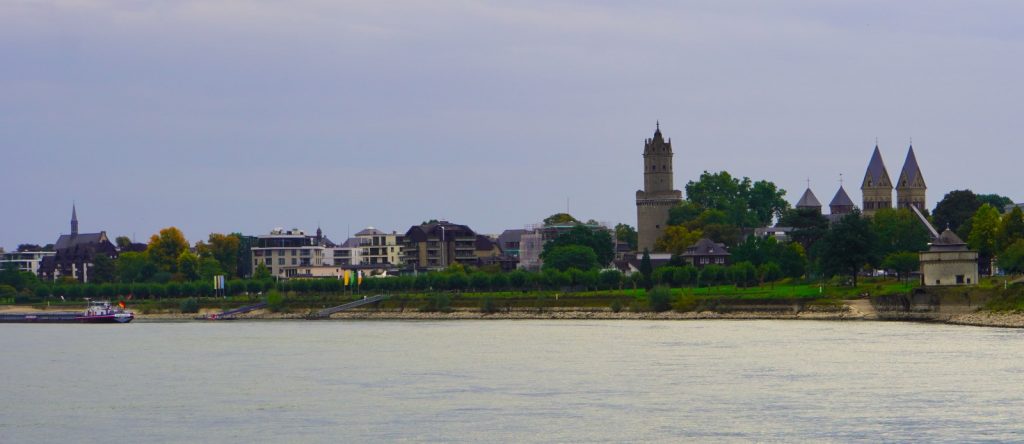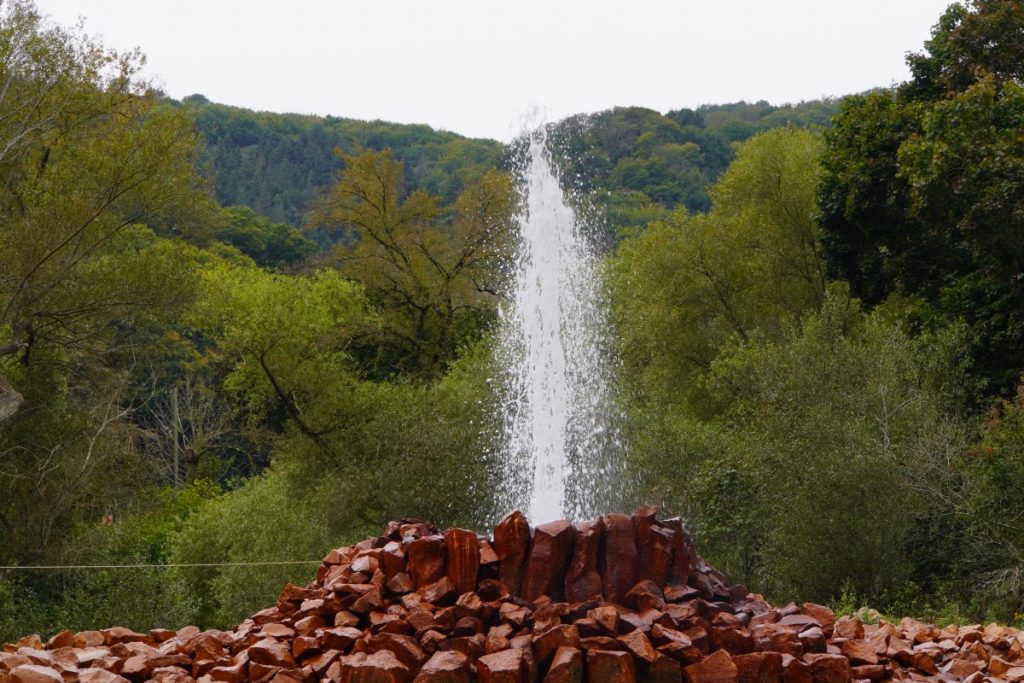Who would have known that the highest cold-water geyser in the world is located on the Rhine? Close to the tranquil town of Andernach, you can visit this geyser from the end of March to the end of October.
It was around 1903 when bubbles were seen rising in the old arm of the Rhine. It was decided to drill on the Namedy peninsula in the hope of finding carbonic acid deposits for the extraction of carbon dioxide for mineral water. 343 metres were drilled into the rock, “awakening” the cold-water geyser to life. The water shot up 40 metres in a powerful eruption.

This geyser was called Namdeyer Sprudel. The water that was emitted there was bottled and used commercially and for tourism. The Namdeyer Sprudel soon became the landmark of the Namedyer Werth.
In 1957, the plant was shut down due to numerous damages. When the nearby federal road was extended, the borehole was closed with a slide valve in 1967. Thus the geyser remained closed for many years.
In 1990, the city of Andernach took over the peninsula and now, despite the strict nature conservation regulations, they planned to market the geyser for tourism. In 2001, a new hole was drilled and a high fountain immediately bubbled up from it. Once again, the borehole was closed with a slide valve.
It took a few years until the city and the Bund für Umwelt und Naturschutz Deutschland (German League for the Environment and Nature Conservation) reached an agreement on the conditions under which the geyser could be used for tourism in the nature reserve.

Initially, there were only a few guided tours in the summer season. In 2009, the Geysir Andernach Adventure Centre opened and since then regular tours by boat to the highest cold-water geyser in the world have been offered. Even today, the borehole is closed with a slide valve as soon as there are no guided tours.
Why does the geyser on the Rhine gush?
There were once volcanoes in the Eifel region. Due to geological disturbances in the rock, carbon dioxide can rise from deep magma chambers.

The geyser near Andernach on the Rhine was created by a 350-metre-deep borehole. Water saturated with carbon dioxide flows into this borehole. Slowly, the borehole fills with the water until the end is finally reached. The water presses with about 35 bar on the water below. The water begins to outgas and releases CO2. The gas bubbles rise and expand more and more. Now a completely normal physical process takes place. In the spatially limited tube, water flows in from below and at the same time the gas bubbles continue to expand. There is no longer enough space and the borehole begins to overflow. The process does not end, however, but the gas bubbles gradually take up more and more space in the borehole. They can only expand upwards and transport the entire amount of water in the borehole out. This is called the geyser jumping.

The eruption lasts about eight minutes and if there is no wind, the water shoots up about 60 metres. Then it is quiet for about 2 hours and the process starts again.
As no water heated by the hot magma bubbles up in Andernach, but cold water escapes, it is the highest cold-water geyser in the world.
So much for the theory – whether this is really the case in practice I experienced live during a visit on site.
Visit to the highest cold water geyser in the world
You can’t visit the geyser just like that. You can only reach it by boat. You can buy tickets at the Geysir Andernach Adventure Centre. These tickets also entitle you to visit the museum and the film show. If possible, you should plan this before visiting the geyser, as the history and functioning of the geyser is explained here in detail. If you want to see everything in detail, you should plan an hour for the visit to the Geyser Museum.
The Geysir Andernach Adventure Centre is located directly on the banks of the Rhine and the boat that takes you to the geyser departs punctually from the shore. The departure times are set so that you are there in time for the eruption of the world’s largest cold-water geyser.

The ship is big and you can sit inside and outside. Even though it was quite fresh, I really enjoyed the trip outside. The Rhine is beautiful and even though the trip is quite short, you can discover a lot along the shore.
After a while the boat moors at a jetty. The excavation site is about 250 m from the jetty and you walk along a well-paved and level path. The whole group that has arrived on the boat is led through the nature reserve to the excavation site and later back again.

And really, as soon as we stood around the eruption site there was a dull sound and the geyser shot up. The cameras clicked, videos were shot and the guide explained what was happening. What a spectacle! I was really impressed by the force of nature with which the water shot up.
Depending on where you stood, a light flight of drops sprayed over to you and the water collected in large puddles on the surrounding meadow. It took quite a while until the fountain slowly became smaller. Every now and then it shot up a little more, until it dried up after 8 minutes.

The guide asked to leave, the boat wanted to leave on time to be back in time for the next outbreak.
In total, the boat trip and the visit to the geyser takes about 1.5 hours.

Address
Geysir-Zentrum Andernach
Konrad-Adenauer-Allee 40
56626 Andernach
Opening hours:
End March – 31 October
daily 9-17:30 h
November – end of March:
Winter break
Ship departure times:
11.15 h, 13.05 h, 15 h, 17 h
Admission fees:
Geyser centre, boat trip, visit to the geyser
Adults: 18,-€
Discounts are offered.
Further information:
There is a municipal car park in Konrad-Adenauer-Allee. You can park there free of charge on Saturdays until 9 a.m. on Mondays.
No, that is not possible.
The boat trip and the visit to the geyser take about 1.5 hours.
No. Only assistance dogs are allowed in the Geyser Centre and at the geyser.
The facility is certified barrier-free in all areas (ship and geyser grounds) in level 2 for people with walking disabilities. (An accompanying person is recommended).
The visit to the geyser was an item on the agenda of a blogger trip to the Rhine.







Leave a Reply